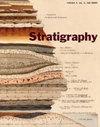An Austral radiolarian biozonation for the Paleogene
IF 0.9
3区 地球科学
Q3 GEOLOGY
引用次数: 14
Abstract
ABSTRACT: We have integrated southern mid- and high-latitude (Austral) radiolarian biozonations with the well-established low-latitude (Tropical) biozonation using new biostratigraphic and magnetostratigraphic constraints on radiolarian bioevents in the Southwest (SW) Pacific, Southeast (SE) Indian and Northwest (NW) Atlantic Oceans. Our primary study sites include Mead Stream, New Zealand, and DSDP Sites 277 and 207 (SW Pacific; 45-54 degrees South at 50 Ma), ODP Site 752 and IODP Site U1514 (SE Indian; 50 degrees South at 50 Ma), and IODP Site U1403 (NW Atlantic; 30 degrees North at 50 Ma). The Austral and Tropical zonal schemes have been calibrated to GPTS2020. We introduce new zonal codes to rectify current confusion surrounding use of "RP" zones. Austral zones are codified as "RPA" zones and Tropical zones are codified as "RPT". Our study finds that radiolarian datums are generally isochronous within the mid-latitude SW Pacific and SE Indian Oceans from Paleocene to middle Eocene and are also isochronous in the high-latitude Southern Ocean (>60 degrees South paleolatitude) over the late middle Eocene to Oligocene interval of overlap. Older radiolarian assemblages are not known from the Southern Ocean. Early to middle Paleocene radiolarian assemblages in the SE Indian Ocean (zones RPA2-RPA5) differ from coeval SW Pacific assemblages by lacking significant numbers of Cretaceous survivors. The reasons for this difference are uncertain. Although the late Paleocene to Eocene radiolarian assemblages in the SW Pacific and SE Indian Ocean lack many low-latitude index species, the timing of Indian Ocean bioevents agrees better with low-latitude biozonations than the SW Pacific, suggesting a stronger connection with low-latitude watermasses. Assemblages from NW Atlantic IODP Site U1403 include numerous low-latitude index species and can be correlated with zones RPT6-RPT13. Many of the species transitions in biostratigraphically important Eocene lineages, however, occur later than in lower latitudes.古近纪南侧放射虫生物分带
摘要:本文利用新的生物地层学和磁地层学约束,对西南太平洋(SW)、东南印度洋(SE)和西北大西洋(NW)的放射虫生物事件进行了整合,将南部中高纬度(南纬)放射虫生物带与已建立的低纬度(热带)放射虫生物带进行了整合。我们的主要研究地点包括米德溪,新西兰和DSDP站点277和207(西南太平洋;45-54°South at 50 Ma), ODP Site 752和ODP Site U1514(东南印度;50°South at 50 Ma)和IODP站点U1403 (NW Atlantic;北纬30度50毫安)。南纬和热带方案已校准为GPTS2020。我们引入新的分区规范,以纠正目前围绕“RP”分区使用的混乱。南方地区被编纂为“RPA”地区,热带地区被编纂为“RPT”地区。研究发现,古新世至中始新世中纬度西南太平洋和东南印度洋的放射虫基准总体上是等时的,在中始新世晚期至渐新世重叠区间,高纬度南大洋(南古纬度>60度)的放射虫基准也是等时的。更古老的放射虫组合还不知道来自南大洋。东南印度洋早至中古新世放射虫组合(RPA2-RPA5带)与同期西南太平洋组合的不同之处在于缺乏大量的白垩纪幸存者。造成这种差异的原因尚不确定。尽管晚古新世至始新世西南太平洋和印度洋东南部的放射虫组合缺乏许多低纬指数物种,但印度洋生物事件的时间比西南太平洋更符合低纬生物带,表明与低纬水团的联系更强。NW Atlantic IODP Site U1403的组合包含大量的低纬指数物种,与RPT6-RPT13带具有相关性。然而,在具有重要生物地层学意义的始新世谱系中,许多物种的转变发生得比低纬度地区晚。
本文章由计算机程序翻译,如有差异,请以英文原文为准。
求助全文
约1分钟内获得全文
求助全文
来源期刊

Stratigraphy
地学-地质学
CiteScore
1.80
自引率
6.70%
发文量
0
审稿时长
>12 weeks
期刊介绍:
The journal’s mission is to publish peer-reviewed papers that use modern stratigraphic tools – biostratigraphy, chemostratigraphy, magnetostratigraphy, cyclostratigraphy, sequence stratigraphy, climatostratigraphy, lithostratigraphy, GSSPs and more – to explore broad ideas in earth history.
 求助内容:
求助内容: 应助结果提醒方式:
应助结果提醒方式:


